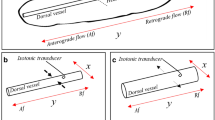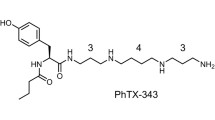Abstract
The Drosophila melanogaster heart is a popular model in which to study cardiac physiology and development. Progress has been made in understanding the role of endogenous compounds in regulating cardiac function in this model. It is well characterized that common neurotransmitters act on many peripheral and non-neuronal tissues as they flow through the hemolymph of insects. Many of these neuromodulators, including acetylcholine (ACh), have been shown to act directly on the D. melanogaster larval heart. ACh is a primary neurotransmitter in the central nervous system (CNS) of vertebrates and at the neuromuscular junctions on skeletal and cardiac tissue. In insects, ACh is the primary excitatory neurotransmitter of sensory neurons and is also prominent in the CNS. A full understanding regarding the regulation of the Drosophila cardiac physiology by the cholinergic system remains poorly understood. Here we use semi-intact D. melanogaster larvae to study the pharmacological profile of cholinergic receptor subtypes, nicotinic acetylcholine receptors (nAChRs) and muscarinic acetylcholine receptors (mAChRs), in modulating heart rate (HR). Cholinergic receptor agonists, nicotine and muscarine both increase HR, while nAChR agonist clothianidin exhibits no significant effect when exposed to an open preparation at concentrations as low as 100 nM. In addition, both nAChR and mAChR antagonists increase HR as well but also display capabilities of blocking agonist actions. These results provide evidence that both of these receptor subtypes display functional significance in regulating the larval heart’s pacemaker activity.




Similar content being viewed by others
References
Baumgartner U, Greffrath W, Treede RD (2012) Contact heat and cold, mechanical, electrical and chemical stimuli to elicit small fiber-evoked potentials: merits and limitations for basic science and clinical use. Neurophysiol Clin Clin Neurophysiol 42(5):267–280. doi:10.1016/j.neucli.2012.06.002
Bier E, Bodmer R (2004) Drosophila, an emerging model for cardiac disease. Gene 342(1):1–11. doi:10.1016/j.gene.2004.07.018
Buccafusco JJ, Beach JW, Terry AV Jr (2009) Desensitization of nicotinic acetylcholine receptors as a strategy for drug development. J Pharmacol Exp Ther 328(2):364–370. doi:10.1124/jpet.108.145292
Cammarato A, Ahrens CH, Alayari NN, Qeli E, Rucker J, Reedy MC, Zmasek CM, Gucek M, Cole RN, Van Eyk JE, Bodmer R, O’Rourke B, Bernstein SI, Foster DB (2011) A mighty small heart: the cardiac proteome of adult Drosophila melanogaster. PLoS One 6(4):11. doi:10.1371/journal.pone.0018497
Campos-Ortega JA (1974) Autoradiographic localization of 3H-gamma-aminobutyric acid uptake in the lamina ganglionaris of Musca and Drosophila. Zeitschrift fur Zellforschung und Mikroskopische Anatomie 147(3):415–431
Collin C, Hauser F, de Valdivia EG, Li S, Reisenberger J, Carlsen EMM, Khan Z, Hansen NO, Puhm F, Sondergaard L, Niemiec J, Heninger M, Ren GR, Grimmelikhuijzen CJP (2013) Two types of muscarinic acetylcholine receptors in Drosophila and other arthropods. Cell Mol Life Sci 70(21):4197. doi:10.1007/s00018-013-1464-4
Colombo SF, Mazzo F, Pistillo F, Gotti C (2013) Biogenesis, trafficking and up-regulation of nicotinic ACh receptors. Biochem Pharmacol 86(8):1063–1073. doi:10.1016/j.bcp.2013.06.023
Consoulas C, Levine RB, Restifo LL (2005) The steroid hormone-regulated gene Broad-Complex is required for dendritic growth of motorneurons during metamorphosis of Drosophila. J Comp Neurol 485:321–337
Cooper AS, Rymond KE, Ward MA, Bocook EL, Cooper RL (2009) Monitoring heart function in larval Drosophila melanogaster for physiological studies. J Vis Exp. doi:10.3791/1596
Coste B, Xiao BL, Santos JS, Syeda R, Grandl J, Spencer KS, Kim SE, Schmidt M, Mathur J, Dubin AE, Montal M, Patapoutian A (2012) Piezo proteins are pore-forming subunits of mechanically activated channels. Nature 483(7388):176–181. doi:10.1038/nature10812
Dasari S, Cooper RL (2006) Direct influence of serotonin on the larval heart of Drosophila melanogaster. J Comp Physiol B-Biochem Syst Environ Physiol 176(4):349–357. doi:10.1007/s00360-005-0058-3
de Castro C, Titlow J, Majeed ZR, Cooper RL (2014) Analysis of various physiological salines for heart rate, CNS function, and synaptic transmission at neuromuscular junctions in Drosophila melanogaster larvae. J Comp Physiol A- Neuroethol Sens Neural Behav Physiol 200(1):83–92. doi:10.1007/s00359-013-0864-0
Desai-Shah M, Papoy AR, Ward M, Cooper RL (2010) Roles of the Sarcoplasmic/Endoplasmic reticulum Ca2-ATPase, plasma membrane Ca2-ATPase and Na/Ca2 exchanger in regulation of heart rate in larval Drosophila. Open Physiol J 3:16–36
Dowse H, Ringo J, Power J, Johnson E, Kinney K, White L (1995) A congenital heart defect in Drosophila caused by an action-potential mutation. J Neurogenet 10(3):153–168. doi:10.3109/01677069509083461
Dulcis D, Levine RB (2003) Innervation of the heart of the adult fruit fly, Drosophila melanogaster. J Comp Neurol 465(4):560–578. doi:10.1002/cne.10869
Dulcis D, Levine RB (2005) Glutamatergic innervation of the heart initiates retrograde contractions in adult Drosophila melanogaster. J Neurosci 25(2):271–280. doi:10.1523/jneurosci.2906-04.2005
Felder CC (1995) Muscarinic acetylcholine receptors—signal-transduction through multiple effectors. Faseb J 9(8):619–625
Gavioli M, Lara A, Almeida PWM, Lima AM, Damasceno DD, Rocha-Resende C, Ladeira M, Resende RR, Martinelli PM, Melo MB, Brum PC, Fontes MAP, Santos RAS, Prado MAM, Guatimosim S (2014) Cholinergic signaling exerts protective effects in models of sympathetic hyperactivity-induced cardiac dysfunction. PLoS One 9(7):9. doi:10.1371/journal.pone.0100179
Gu GG, Singh S (1995) Pharmacological analysis of heartbeat in Drosophila. J Neurobiol 28(3):269–280. doi:10.1002/neu.480280302
Gundelfinger ED, Schloss P (1989) Nicotinic acetylcholine receptors of the Drosophila central nervous system. J Protein Chem 8(3):335–337. doi:10.1007/bf01674267
Horta BL, Victora CG, Menezes AM, Halpern R, Barros FC (1997) Low birthweight, preterm births and intrauterine growth retardation in relation to maternal smoking. Paediatr Perinat Epidemiol 11(2):140–151. doi:10.1046/j.1365-3016.1997.d01-17.x
Hukkanen J, Benowitz NL (2005) Metabolism and disposition kinetics of nicotine. Pharmacol Rev 57(1):79–115. doi:10.1124/pr.57.1.3
Hurst R, Rollema H, Bertrand D (2013) Nicotinic acetylcholine receptors: from basic science to therapeutics. Pharmacol Ther 137(1):22–54. doi:10.1016/j.pharmthera.2012.08.012
Huser A, Rohwedder A, Apostolopoulou AA, Widmann A, Pfitzenmaier JE, Maiolo EM, Selcho M, Pauls D, von Essen A, Gupta T, Sprecher SG, Birman S, Riemensperger T, Stocker RF, Thum AS (2012) The serotonergic central nervous system of the drosophila larva: anatomy and behavioral function. PLoS One 7(10):23. doi:10.1371/journal.pone.0047518
Johnson E, Ringo J, Dowse H (1997) Modulation of Drosophila heartbeat by neurotransmitters. J Comp Physiol B-Biochem Syst Environm Physiol 167(2):89–97. doi:10.1007/s003600050051
Johnson E, Ringo J, Bray N, Dowse H (1998) Genetic and pharmacological identification of ion channels central to the Drosophila cardiac pacemaker. J Neurogenet 12(1):1–24
Johnson E, Ringo J, Dowse H (2001) Dynamin, encoded by shibire, is central to cardiac function. J Exp Zool 289(2):81–89. doi:10.1002/1097-010x(20010201)289:2<81:aid-jez1>3.0.co;2-t
Johnstone AFM, Cooper RL (2006) Direct innervation of the Drosophila melanogaster larval aorta. Brain Res 1083:159–163. doi:10.1016/j.brainres.2006.02.007
Majeed ZR, Nichols CD, Cooper RL (2013) 5-HT stimulation of heart rate in Drosophila does not act through cAMP as revealed by pharmacogenetics. J Appl Physiol 115(11):1656–1665. doi:10.1152/japplphysiol.00849.2013
Majeed ZR, Stacy A, Cooper RL (2014) Pharmacological and genetic identification of serotonin receptor subtypes on Drosophila larval heart and aorta. J Comp Physiol B-Biochem Syst Environm Physiol 184(2):205–219. doi:10.1007/s00360-013-0795-7
Martin CA, Krantz DE (2014) Drosophila melanogaster as a genetic model system to study neurotransmitter transporters. Neurochem Int 73:71–88. doi:10.1016/j.neuint.2014.03.015
McCann FV (1970) Physiology of insect hearts. In: Smith, Ray F, Thomas E Mittler (eds) Annual review of entomology Vol 15 Vii + 502p Illus annual reviews, Inc, Palo Alto, pp 173–200
Molina MR, Cripps RM (2001) Ostia, the inflow tracts of the Drosophila heart, develop from a genetically distinct subset of cardial cells. Mech Dev 109(1):51–59. doi:10.1016/s0925-4773(01)00509-3
Moonschi FH, Effinger AK, Zhang XL, Martin WE, Fox AM, Heidary DK, DeRouchey JE, Richards CI (2015) Cell-derived vesicles for single-molecule imaging of membrane proteins. Angewandte Chemie-Int Edn 54(2):481–484. doi:10.1002/anie.201408707
Neve KA, Seamans JK, Trantham-Davidson H (2004) Dopamine receptor signaling. J Recept Signal Transduction 24(3):165–205. doi:10.1081/lrst-200029981
Nurminen ML, Paakkari I, Seppala T (1991) Serotonergic involvement in the cardiovascular stimulation by thyrotropin-releasing hormone (Trh) in anesthetized rats. Neurosci Lett 127(2):147–149. doi:10.1016/0304-3940(91)90781-n
Ocorr K, Reeves NL, Wessells RJ, Fink M, Chen HSV, Akasaka T, Yasuda S, Metzger JM, Giles W, Posakony JW, Bodmer R (2007) KCNQ potassium channel mutations cause cardiac arrhythmias in Drosophila that mimic the effects of aging. Proc Natl Acad Sci USA 104(10):3943–3948. doi:10.1073/pnas.0609278104
Paradiso KG, Steinbach JH (2003) Nicotine is highly effective at producing desensitization of rat alpha 4 beta 2 neuronal nicotinic receptors. J Physiol Lond 553(3):857–871. doi:10.1113/jphysiol.2003.053447
Piazza N, Wessells RJ (2011) Drosophila Models of Cardiac Disease. In: Chang KT, Min KT (eds) Progress in molecular biology and translational science, vol 100. Elsevier Academic Press Inc, San Diego, pp 155–210. doi:10.1016/b978-0-12-384878-9.00005-4
Ren GR, Folke J, Hauser F, Li S, Grimmelikhuijzen CJ (2015) The A- and B-type muscarinic acetylcholine receptors from Drosophila melanogaster couple to different second messenger pathways. Biochem Biophys Res Commun 462(4):358–364. doi: 10.1016/j.bbrc.2015.04.141
Rizki TM (1978) The circulatory system and associated cells and tissues. In: Ashburner M, Wright TRF (eds) The genetics and biology of Drosophila. vol 2b. Academic Press, USA
Ropert N, Krnjevic K (1982) Pharmacological characteristics of facilitation of hippocampal population spikes by cholinomimetics. Neuroscience 7(8):1963–1977. doi:10.1016/0306-4522(82)90011-2
Schreiner BSP, Lehmann R, Thiel U, Ziemba PM, Beltran LR, Sherkheli MA, Jeanbourquin P, Hugi A, Werner M, Gisselmann G, Hatt H (2014) Direct action and modulating effect of (+)- and (−)-nicotine on ion channels expressed in trigeminal sensory neurons. Eur J Pharmacol 728:48–58. doi:10.1016/j.ejphar.2014.01.060
Schuster R, Phannavong B, Schroder C, Gundelfinger ED (1993) Immunohistochemical localization of a ligand-binding and a structural subunit of nicotinic acetylcholine-receptors in the central nervous system of Drosophila melanogaster. J Comp Neurol 335(2):149–162. doi:10.1002/cne.903350202
Stewart BA, Atwood HL, Renger JJ, Wang J, Wu CF (1994) Improved stability of Drosophila larval neuromuscular preparations in hemolymph-like physiological solutions. J Comp Physiol A- Sens Neural Behav Physiol 175(2):179–191. doi:10.1007/bf00215114
Subramani S, Subbanna PK (2006) Calcium-transporters in myocardial cells. Indian J Physiol Pharmcol 50:99–113
Talavera K, Gees M, Karashima Y, Meseguer VM, Vanoirbeek JAJ, Damann N, Everaerts W, Benoit M, Janssens A, Vennekens R, Viana F, Nemery B, Nilius B, Voets T (2009) Nicotine activates the chemosensory cation channel TRPA1. Nat Neurosci 12(10):1293–1299. doi:10.1038/nn.2379
Titlow JS, Rufer J, King K, Cooper RL (2013) Pharmacological analysis of dopamine modulation in the Drosophila melanogaster larval heart. Physiol Rep 1(2):e00020. doi:10.1002/phy2.20
Wadsworth SC, Rosenthal LS, Kammermeyer KL, Potter MB, Nelson DJ (1988) Expression of a Drosophila melanogaster acetylcholine-receptor-related gene in the central nervous system. Mol Cell Biol 8(2):778–785
Wolf MJ, Amrein H, Izatt JA, Choma MA, Reedy MC, Rockman HA (2006) Drosophila as a model for the identification of genes causing adult human heart disease. Proc Natl Acad Sci USA 103(5):1394–1399. doi:10.1073/pnas.0507359103
Wonnacott S, Livingstone PD (2010) Nicotinic receptors and the modulation of transmitter release in the prefrontal cortex. Eur Neuropsychopharmacol 20:S193
Zeitouni B, Senatore S, Severac D, Aknin C, Semeriva M, Perrin L (2007) Signalling pathways involved in adult heart formation revealed by gene expression profiling in drosophila. PLoS Genet 3(10):1907–1921. doi:10.1371/journal.pgen.0030174
Zornik E, Paisley K, Nichols R (1999) Neural transmitters and a peptide modulate Drosophila heart rate. Peptides 20(1):45–51. doi:10.1016/s0196-9781(98)00151-x
Acknowledgments
This work was funded by the G. Ribble fellowship from Dept. of Biology, Univ. of KY (CM). KR and JR were supported by KY IDEA Network of Biomedical Research Excellence Grant #P20GM103436. Personal funds supplied by RLC.
Author information
Authors and Affiliations
Corresponding author
Ethics declarations
Conflict of interest
The authors declare that they have no conflict of interest.
Additional information
Communicated by G. Heldmaier.
Rights and permissions
About this article
Cite this article
Malloy, C.A., Ritter, K., Robinson, J. et al. Pharmacological identification of cholinergic receptor subtypes on Drosophila melanogaster larval heart. J Comp Physiol B 186, 45–57 (2016). https://doi.org/10.1007/s00360-015-0934-4
Received:
Revised:
Accepted:
Published:
Issue Date:
DOI: https://doi.org/10.1007/s00360-015-0934-4




